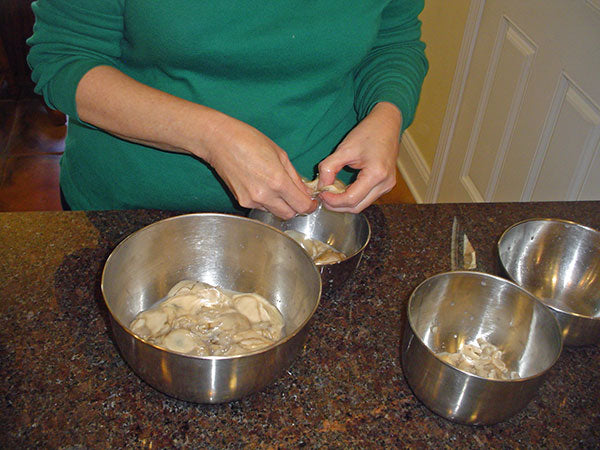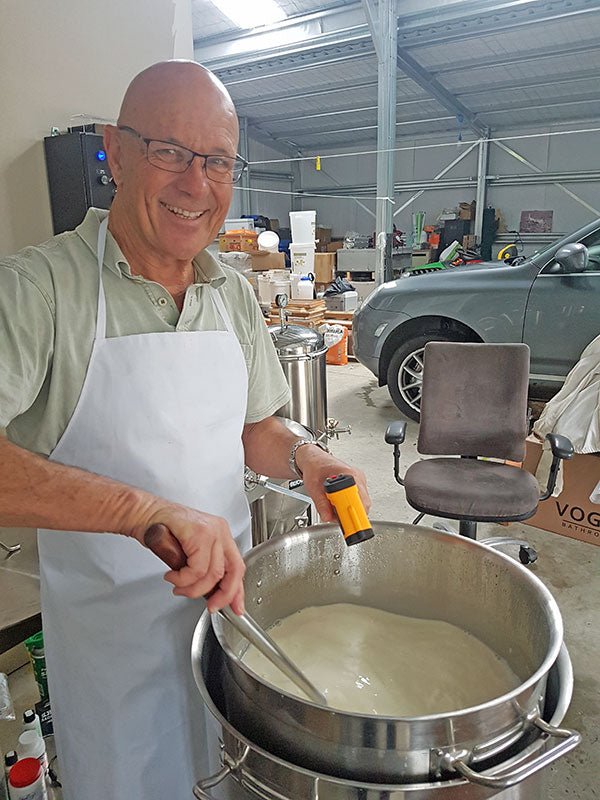
Oyster Pork Pie
By Bob Albers*
Many families have an heirloom recipe. Mine is no exception. This recipe for oyster pork pie was handed down through the generations, we think, from Bernadina Albers Purkert (1852-1933). Lets call her Bernadina #1. Of course, I’m digging up some very old memories of what I was told as a child some 65± years ago, so I really can’t vouch for the accuracy.
It is believed that Bernadina #1 devised the recipe and passed it on to her nieces, Lisa and Bernadina (#2) Albers as she had no children of her own. When her nephew, Henry married, Bernadina #2 passed it to his first wife Mary, then to his second wife Marie who passed it to my mother. My mother passed the recipe to my sisters and my wife. WOW! How many cooks it was passed down to?
Surely, they all added their own twist to what they were taught. I know for a fact that Bernadina #1 didn’t have pre-made pie crust from the grocery. I don’t think that variation came along until my sisters and wife made it. Even in the current generation there are differences between how my wife makes it and how my younger sister Marie does. Hers is a bit firmer than my wife’s so I asked her to make me a pie for my birthday and show me how it’s done. Here’s a photo of the ingredients before she began making the pie.
Now, remember I asked for “a” pie for my birthday. Marie doesn’t do it in any small measure. She does it on an industrial scale. By the time we were done, we had enough filling for 5 pies. This is the way she normally does it. I took home enough for 2 pies & she kept the rest for her family. It seems my nephew Kyle shares my taste – he also asked for a pie. The list of ingredients is:
1 gallon of shucked oysters
1½ tsp. chopped garlic
¾ c. creole seasoning aka trinity
corn starch
black pepper
salt
7 lbs not so lean, not so fat pork chops
1 tbsp. olive oil
Tony Chachere’s seasoning
5 Seasons Italian seasoning
bay leaves
1 stick unsalted butter
I realize that some brand names might not be available around the country. Anyone not living in South Louisiana might have to interpret the intent.
Because she makes such a large amount at one time, she uses a very large 7 quart pan pictured here.

First, we prepare the pork chops by dusting them liberally on both sides with the Tony Chachere’s seasoning mix, shown here.

Now, we put 1 tbsp. of olive oil in the skillet with about 2 tbsp. of the Guidry’s Creole seasoning mix (trinity), ¾ tsp. of minced garlic and saute until the onions begin to become translucent. Top with a layer of pork chops. This is to begin infusing the trinity & garlic flavors into the pork. Turn them over as necessary.

When the pork chops are cooked, they are removed from the pan and cooled. This is the first batch.

The next batch of pork is cooked with another 2 tbsp. or thereabouts of the Guidry’s seasoning and more minced garlic added. (the first portion of the trinity was left in the skillet).

Once all the pork is cooked, it is cubed into pieces about ¾ inch on a side. The quarter in the upper part of the photo is shown for size comparison.

The pork is added back to the pan along with 3 bay leaves, the 5 Seasons Italian seasoning and ½ stick of butter and the rest of the Guidry’s trinity mix. It now simmers over a very low flame for about ½ hour.

While the mixture is simmering and the pork is becoming more tender, we turn our attention to the oysters.

Bear is also paying attention.

We found we had 5 dozen small, 2½ dozen medium and 1 dozen large oysters. We didn’t use the large oysters. I ate the biggest one of them raw.
Here, my sister does something I have never seen before. She removes the mussel from the oysters. She says that she does it to eliminate any possibility of getting a small piece of oyster shell in the pie.

A well is made in the seasoned pork mixture to add the small and medium oysters + ½ stick butter. As the oysters cook, they release a lot of water which mixes with the juices from the pork and vegetables.

When the oysters have cooked for about 5 minutes, they are mixed in with everything else while still simmering.

At this time, the filling is too liquid even though it has been reducing for the last hour or so of simmering. A cup of the liquid is removed and thoroughly mixed with a tbsp. of corn starch. The liquid is returned to the pot, simmered for about 2 or 3 minutes and checked for consistency again. It was still too thin, so the step was repeated until the liquid was thick like a gravy.

Now its time to sample the filling and correct the seasoning.

It’s hot! I have to blow on it. But yummy.

The salt and pepper are added (to taste) last because the salinity of the oysters is variable. I took home enough of the filling for 2 pies. I refrigerated the filling over night.

My camera malfunctioned the next day so I don’t have a photo of the finished pie. I placed one of the 2 Pillsbury pie crusts in the bottom of a 9 inch pie pan, filled it with half of the filling (I brought home enough for 2). Before placing the upper crust, I cut vent holes in it with a small cookie cutter. The whole pie was cooked for ½ hour at 350°F (until the upper crust was browned).
As I said in the beginning, many cooks have passed this recipe down through time and modified it to suit their taste and ingredients available at that time. I remember my mother chopping the onion, celery and bell pepper to make her own trinity. Seasoning mixes weren’t available back then so the work was even more involved. Back then, if you wanted to eat an oyster, you could buy a 50 lb. sack and shuck them yourself.
I’ve often wondered if the original Bernadina would recognize her creation. Would she like it as much as we do?
The bottom line is I enjoyed my birthday pie. Thank you Marie!
 *About Bob
*About Bob
Bob is a retired electronics engineer who has traveled all around the world, but now lives in Mandeville, Louisiana. He has written 8 articles for us so far (including this one), and we have done one about him (click here). We’re very grateful to him for his contributions to our community of home cheese makers.
These are his previous articles, listed in order with the most recent at top:
Kummelkase (Caraway Cheese)
Cream Cheese Experiment
Bob’s Homemade Curd Cutter – Part 2
Bob’s Homemade Horizontal Curd Cutter
Making a Drying Box
About Cooking Curds
Creole Cream Cheese














































































































































